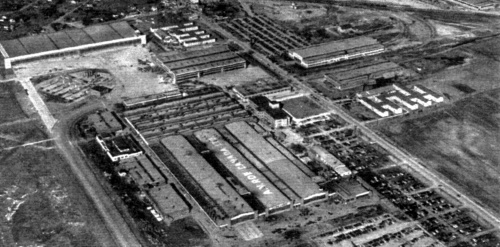A.V. Roe Canada
From The Space Library
An aerial view of the A.V. Roe factory in Malton Ontario circa 1954.
A.V. Roe Canada was first based at the Victory aircraft plant in Malton Ontario. Victory aircraft had been a Crown corporation in Canada. The 750,000 sq ft factory in Malton had been begun by the National Steel Car company in 1938 and was completed in 1942.
Victory aircraft had been manufacturing Avro Lancaster bombers at the location all through World War II.
C.D. Howe Minister of Munitions and Supply in Canada agreed to sell the factory to Sir Roy Dobson in the summer of 1945, right at the end of hostilities. Dobson was managing director of A.V. Roe and Company Limited based in Manchester England. The deal made was for A.V. Roe to commit to designing and building all manner of aircraft both commercial and military, as well as establishing an engine turbine division.
An exchange of designers took place between the Manchester and Malton facilities to expedite production of aircraft like the Tutor II. The sale from the government to A.V. Roe was finalised on December 1st 1945.
J.P. Bickell was the first company chairman.
By January 1946 the company had announced that it would be designing and building a jet-propelled fighter for the Royal Canadian Air Force.
A.V. Roe Canada took over the Crown Corporation Turbo Research Limited in the late 1940s. Turbo Research built the Chinook gas turbine engine. By January 1948 Turbo Research employed 450 people. Also in 1948 plans were well underway for a 30 to 40 seat civilian jet aircraft which became known as the C-102, later The Jetliner; the brainchild of Project designer James C. Floyd, an immigrant engineer from Manchester England.
On August 10th 1949 The Jetliner took to the air for the first time powered by four Rolls Royce Derwent jet engines, with Jimmy Orrell and Don Rogers at the controls. The final aircraft was capable of carrying 50 passengers at a cruising speed of 430 mph. The Jetliner was the first civilian jet transport to fly in North America and missed being the world's first by only a matter of days. The Jetliner would be shelved soon after despite getting accolades from around the world, including from Howard Hughes.
By February 1950 the Orenda turbojet engine was being constructed at Malton and almost ready to be deployed. It was rated for 6000 lbs thrust and was designated to be incorporated in the jet fighter known as the CF-100.
The CF-100 had been flown for the first time by Squadron Leader Bill Waterton on January 19th 1950; powered by two Rolls Royce Avon engines. At the time it was the most powerful fighter available in the Commonwealth.
By the summer of 1951 a new engine plant was under construction at Malton where the Orenda engine and the CF-100 would be manufactured. The plant was officially opened by C.D. Howe on September 29 1952.
In October 1951 Crawford Gordon Jr took over as General Manager. By the summer of 1954 a new supersonic interceptor program was initiated, to be designated the CF-105 with chief engineer James Floyd in charge. Meanwhile, J.C.M, Frost was already conducting experiments with Project Y, a radical design cloaked in secrecy and later often referred to as the source for many flying disc anecdotes.
Around this time work also began on the Avrocar, a cushion effect vertical take-off flying disc. The project was undertaken with funding by the United States Air Force. The Avrocar would never attain more than a few feet altitude and was quickly shelved.
The CF-105 project would continue until the aircraft was rolled out of the hangar for the first time on October 4th 1957. It flew for the first time in 1958 powered by General Electric engines. It attained a speed of almost Mach 2 while in a climb and almost broke the world speed record.
Orenda Engines had been designing and building an advanced power-plant for the CF-105 called the Iroquois. The CF-105 never flew with the Iroquois engine but many observers believed the aircraft would have easily been the fastest in the world. The program was cancelled in February 1959 after a handful of CF-105s had already been built. Almost 13,000 A.V. Roe employees were laid off and the company began a slow slide downhill.
Despite being given a small contract in the summer of 1959 to build General Electric engines to power the Lockheed 104G fighter, A.V. Roe Canada would never fully recover from the cancellation of the CF-105 project. On December 18th 1959 the A.V. Roe parent company, Hawker Siddeley, purchased De Havilland and began the consolidation of the two Canadian aircraft companies.
A.V. Roe's Applied Research Division was merged with De Havilland's Special Projects Division to create Special Projects Applied Research or SPAR. This company would go on to build the robotic arm for the Space Shuttle.

